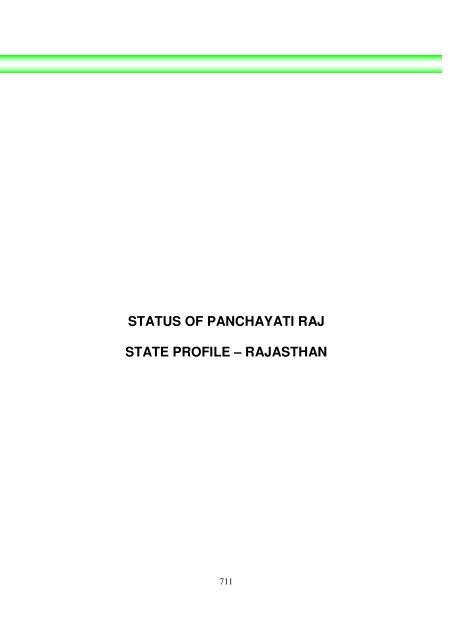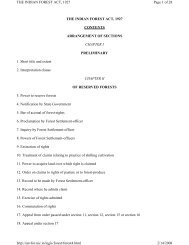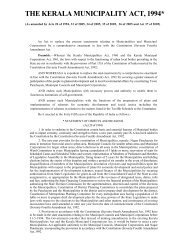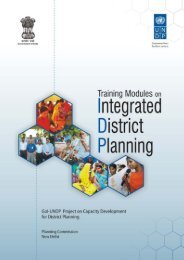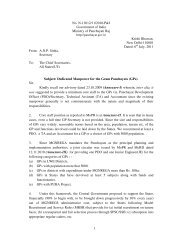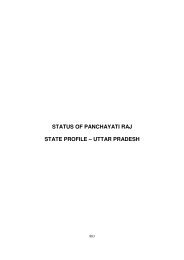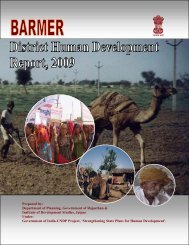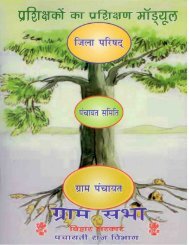status of panchayati raj state profile â rajasthan - nrcddp
status of panchayati raj state profile â rajasthan - nrcddp
status of panchayati raj state profile â rajasthan - nrcddp
Create successful ePaper yourself
Turn your PDF publications into a flip-book with our unique Google optimized e-Paper software.
Introduction:The total population <strong>of</strong> Rajasthan is 5.65 crore (2.942 crore men and 2.708 crore women). Theliteracy rate <strong>of</strong> Rajasthan is 60.4% as per the census <strong>of</strong> 2001. The rural population is 76.72percent.Rajasthan’s Panchayati Raj Act was passed on 23-4-1994 pursuant to the 73 rd Amendment Act,1992. This came into effect on April 23, 1994. Certain important amendments were made in1999, 2000 and 2004. Under this legislation, Panchayats at all the three levels have beenentrusted with duties and functions with regard to all the 29 matters listed in the EleventhSchedule <strong>of</strong> the Constitution.Table 1: Nomenclature used for the three levels <strong>of</strong> PanchayatsLevel <strong>of</strong> PanchayatDistrict PanchayatIntermediate PanchayatVillage PanchayatName usedZilla ParishadPanchayat SamitiGram PanchayatBasic Statistics concerning Panchayati Raj in Rajasthan:Table 2: Number <strong>of</strong> Panchayats at each level 1 :1 Zilla Parishad 322 Panchayat Samiti 2373 Gram Panchayat 9188Total 9457Number <strong>of</strong> Elected Panchayat Representatives at each level 2 :Table 3-A: Gram PanchayatNo. <strong>of</strong> elected representativesGeneral SC ST OBC Total Women1 2 3 4 5 6 7Sarpanch 1767 1692 2030 3688 9177 3338Percentage 19.25 18.44 22.12 40.19 36.37Ward Panch 19584 22426 18214 44140 104364 36674Percentage 18.77 21.49 17.45 42.29 100 35.141 Rajasthan Election Commission’s Report2 Rajasthan Election Commission’s Report712
Table 3-B: Panchayat SamitiNo. <strong>of</strong> elected representativesGeneral SC ST OBC Total Women1 2 3 4 5 6 7Total 1190 1058 980 2028 5256 2013Percentage 22.64 20.13 18.65 38.58 100 38.30Table 3-C: Zilla ParishadNo. <strong>of</strong> elected representativesGeneral SC ST OBC Total Women1 2 3 4 5 6 7Total 257 188 186 376 1007 377Percentage 25.52 18.67 18.47 37.34 100 37.44Dimension 1: Effective Devolution <strong>of</strong> FunctionsThrough the Rajasthan Panchayati Raj Act 1994, the State has devolved all 29 functionsincluded in the Eleventh Schedule <strong>of</strong> the Constitution.Orders were first issued on 19.06.2003 regarding transfer <strong>of</strong> powers to PRIs as per 29 subjectslisted in 11 th Schedule <strong>of</strong> the Constitution in view <strong>of</strong> the spirit <strong>of</strong> 73 rd Constitutional Amendment1992. Functions <strong>of</strong> 18 departments and funds and functionaries <strong>of</strong> 16 departments weretransferred, though subsequently the Government has stayed transfer <strong>of</strong> staff <strong>of</strong> PHED, Foodand PWD department staff. A fresh exercise <strong>of</strong> Activity Mapping on the lines <strong>of</strong> the Task ForceReport <strong>of</strong> 2001 <strong>of</strong> Ministry <strong>of</strong> Rural Development has been completed now for 18 Departments,namely, Primary Education, Fisheries, Health, Social Welfare, PHED, Ayurveda, Agriculture andAgricultural Extension, Land and Water Conservation, ICDS, Animal husbandry, RajasthanAkhshay Urja, Irrigation, forestry, PWD, Tourism, Industry, Technical Edu. Food and CivilSupplies. The matter is pending at the highest level in the <strong>state</strong> government for approval.Dimension 2: Effective Devolution <strong>of</strong> FunctionariesThere is no Panchayati Raj Administrative and Technical Service <strong>of</strong> <strong>of</strong>ficials and technocrats.Rajasthan, earlier, used to have a system <strong>of</strong> screening staff from other departments, givingthem special pay to motivate them to work in Panchayats. From 2003-04 onwards, the ZilaPramukhs and Pradhans have been made the reporting <strong>of</strong>ficer for CRs <strong>of</strong> CEOs/ACEOs andBDOs respectively. The Government has now constituted a Cabinet Committee to take decisionon formation <strong>of</strong> Rajasthan Gramin Vikas Seva. Rules for Gramin Abhiyantriki Seva (RuralEngineering Service) have also been prepared.The <strong>status</strong>es <strong>of</strong> devolution <strong>of</strong> functionaries at the Zilla Parishad level are as under 3 :3 State Chief Secretary’s order dated 19.06.03713
Table 4-A:SubjectDevolved1. Agriculture Investigator,Jr. Acctt.UDC, LDC,Driver, PeonMinisterial2. Minorirrigation3. ForestDepartment4. PHEDDepartment5. Education Ministerialstaff6. Socialwelfare7. FisheriesDepartment8. Womanand childdeptt.9. SoilConservationDesignation(s) <strong>of</strong> FunctionariesGeneral TechnicalCategory CategoryAsstt. Director,AgricultureExtension with 3AgricultureOfficers with staffstaff <strong>of</strong> (ZP) Agriculture<strong>of</strong>ficers. supervisors &Asstt. Agriculture<strong>of</strong>ficers (PS)Ministerial Asstt. Engineerstaff (ZP)Junior Engineer(IP)- Asstt. ForestConservatorStaff Asstt. Engineer(Kept inAbeyance)MinisterialstaffMinisterialstaffMinisterialstaffMinisterialstaffDistt. Education<strong>of</strong>ficer (ZP)Block education<strong>of</strong>ficers (IP)Dy. Director/ Asstt.Director/ Socialwelfare<strong>of</strong>ficer/DistrictProject <strong>of</strong>ficer (ZP)District Fisheries<strong>of</strong>ficers (ZP)Dy. Director ICDSand projectDirector (DWDA(ZP)CDPO andSupervisors (IP)Anganwadiworkers (GP)District andconservation<strong>of</strong>ficerAsstt. EngineerProject Officers(ZP)Extent <strong>of</strong> SubordinationDisciplinaryAuthorityZila Parishad for MinorPenalties(Upto Stoppage <strong>of</strong> 2grade increments)Concerned PRI forMinor Penalties.(Upto Stoppage <strong>of</strong> 2grade increments)Executive EngineerPHEDConcerned PRI forMinor Penalties(Upto Stoppage <strong>of</strong> 2grade increments)ZP for Minor Penalties(Upto Stoppage <strong>of</strong> 2grade increments)ZP for Minor Penalties(Upto stoppage <strong>of</strong> 2grade increments)ZP for Minor Penalties(Upto Stoppage <strong>of</strong> 2grade incrementsZP for Minor Penalties(Upto Stoppage <strong>of</strong> 2grade increments)SupervisoryAuthorityDirector Agriculture.ChiefirrigationChief EngineerForestChief EngineerPHEDDirector primaryeducation.Director SocialWelfare.EngineerDirector FisheriesDirector Women andChild Deptt.Director WatershedDevelopment andSoil Conservation714
The Status <strong>of</strong> Devolution <strong>of</strong> Functionaries <strong>of</strong> devolved subjects at the Panchayat Samiti levelare as under 4 :Table 4-B:SubjectDevolved1. Agriculture Ministerial staff<strong>of</strong> <strong>of</strong>fice2. Minorirrigation3. PHEDDepartment4. IndustriesDepartmentDesignation(s) <strong>of</strong> FunctionariesGeneral TechnicalCategory CategoryAgriculturesupervisors &Asstt.Agriculture<strong>of</strong>ficers- MaintenancestaffStaffJunior Engineer(Kept inAbeyance)- Inspector Khadiand VillageIndustries5. Education Ministerial staff Block education<strong>of</strong>ficers6. Woman andChildDepartment7. Food andCivil suppliesDeptt.8. Medical andHealth Deptt.Ministerial staffProject OfficersICDS along withsupervisors- EnforcementInspectors(Kept inAbeyance)- Dy. CMHO(ZP)In-charge PHC(IP)ANM & MHW(GP)9. Forest Deptt. - Forest Rangerand 2Foresters/Asstt. ForestersExtent <strong>of</strong> SubordinationDisciplinary Supervisoryauthority Authority.Zilla Parishad DirectorAgricultureConcerned PRIXEN PHEDSecretary Khadiand VillageIndustriesBoardIP for MinorPenalties (uptoStoppage <strong>of</strong> 2gradeincrements)Zilla Parishad(Upto stoppage<strong>of</strong> 2 gradeincrements)IPDistrict Medicaland HealthOfficerIP for MinorPenalties(Upto stoppage<strong>of</strong> 2 gradeincrements)Chief EngineerIrrigationChief EngineerPHEDDirector IndustriesDirector PrimaryEducationDirector Womanand Child Deptt.FoodCommissionersDirector Medicaland HealthChief ConservatorForest.The Status <strong>of</strong> Devolution <strong>of</strong> Functionaries <strong>of</strong> devolved subjects at Gram Panchayat level are asunder 5 :4 State Chief Secretary’s order dated 19.06.03715
Table 4-C:Subject Designations <strong>of</strong> functionaries Extent <strong>of</strong> SubordinationDevolved GeneralCategoryTechnicalCategoryDisciplinaryAuthoritySupervisoryAuthority1. Agriculture - VEW to discuss District Directorprogress and Agriculture Agricultureannual plan in GP Officer2. Minor - Maintenance staff XEN Irrigation Chief EngineerIrrigationIrrigation3. PHED - Hand pump IPXEN PHEDDepartmentmachine4. Women and - Anganwadi Project Officer Director WomenChildWorkerICDSand ChildDepartment5. Medical andHealth- ANM and MHW In-chargePrimary HealthDirector Medical &HealthDepartmentCentre6. Education - Para Teacher IP GP7. Rural - Gram Sewak-cum- IPGPDepartmentSecretary GPThe DRDA has been merged in Zilla Parishad since 30.8.2003 and renamed as RuralDevelopment Cell <strong>of</strong> Zilla Parishad.Dimension 3: Effective Devolution <strong>of</strong> FinancesIn 2004-05 a budget provision was made for introducing a grant-in-aid for PRIs in the budgetprovisions made by each department dealing with the 29 functions. The State therefore has adistrict sector/Panchayat window in its budget and funds are being provided through this budgetwindow to the Panchayats. It has to be ascertained that all funds pertaining to activitiesdevolved to PRIs are provided through the Budget Window to the Panchayats. The Ministry <strong>of</strong>Panchayati Raj is undertaking a detailed pilot study in this matter. However, it is certain thatonce activity mapping is done, funds can be immediately appropriated to the Panchayat sector,because the provision for the same already exists.The details <strong>of</strong> the quantum <strong>of</strong> untied funds reaching each Panchayat are indicated below 6 :Table 5-A: Funds Allocated to PRIs under recommendation <strong>of</strong> SFC_IISl. Financial YearRecommendation <strong>of</strong> SecondSFC (in Lakh Rs.)Actual Allocation(In Lakh Rs.)1 2000-2001 8124.38 8124.382 2001-2002 9251.00 9251.003 2002-2003 9386.67 9386.674 2003-2004 9386.67 9386.675 2004-2005 13554.10 13554.105 State Chief Secretary’s order dated 19.06.036 SFC and 11 th Finance Commission’s Report716
Table 5-B: Funds Allocated to PRIs under recommendation <strong>of</strong> 11 th FCSl. Financial Year Fund recommended by11 th FinanceCommission (In LakhRs.)Actual Allocation (InLakh Rs.)1 2000-2001 9818.96 4909.482 2001-2002 9818.96 14728.443 2002-2003 9818.96 4909.484 2003-2004 9818.96 0-005 2004-2005 9818.96 24547.40State Finance Commissions:So far, three State Finance Commissions have been appointed. The details <strong>of</strong> therecommendations <strong>of</strong> the first and second State Finance Commissions are as follows:First SFC (1995-2000)Resource Sharing2.18 % <strong>of</strong> the net <strong>state</strong> tax proceeds may be devolved on the local bodies. The share <strong>of</strong> thePRIs and the ULBs out <strong>of</strong> the divisible pool would be in the ratio <strong>of</strong> 3.4:1, namely, the proportion<strong>of</strong> rural / urban population according to the 1991 census.Assignments <strong>of</strong> Taxes• A nominal 10 % tax on land rent could be imposed by all Panchayat Samitis in the State.• The State Government may consider vesting powers <strong>of</strong> imposition <strong>of</strong> land revenue on baraniland 7 to ZPs.• ZPs should levy a surcharge <strong>of</strong> 1 % on the sale <strong>of</strong> land in rural areas and ½ % surcharge onmarket fee.• The panchayats should levy taxes or fees on dhabas, hotels, automobile servicing andrepair shops, petrol and diesel pumps etc., situated on the national and <strong>state</strong> highways intheir respective areas.AllocationDevelopmental assistance provided in Tenth Finance Commissions recommendations andmatching contribution recommended may be distributed to GPs on the following basis:• 50 % on the basis <strong>of</strong> incidence <strong>of</strong> property• 40 % on the basis <strong>of</strong> total rural population• 10 % on the basis <strong>of</strong> population in the non-Desert Development Programmes / non-Drought Prone Area Programmes / non-Tribal Area Development blocks.7 Agriculture purely depends on rainfall717
Land revenue on barani land may be shared by PRIs in the ratio <strong>of</strong> 60 % to GPs, 25% to PSsand 15 % to ZPs.Grants• Grants for maintenance <strong>of</strong> rural roads and buildings may be given at Rs. 5000/- perpanchayat and at Rs. 10,000/- per Panchayat Samities to maintain <strong>of</strong>fice buildings and staffquarters. Zilla Parishads may be given Rs. 20,000 per Zilla Parishad per annum.• One time ‘start-up’ grant <strong>of</strong> Rs. 5000/- may be given to each <strong>of</strong> 1856 Gram Panchayatsnewly created due to delimitation exercises carried out before the constitution <strong>of</strong> theCommission.• Incentive grants may be given to each level <strong>of</strong> PRIs for functional improvement, and betterperformance :(a) Three cash awards for Gram Panchayats at each district level every year, <strong>of</strong> Rs. 2 lakhs,Rs. 1 lakh & Rs. 50000 each,(b) Cash awards to Panchayat Samities at the Divisional level every year <strong>of</strong> Rs. 8 lakhs, Rs.5 lakhs and Rs. 2 lakhs,(c) Cash awards to Zilla Parishads at State level every year <strong>of</strong> Rs. 8 lakhs, Rs. 5 lakhs andRs. 2 lakhs.• Grants <strong>of</strong> Rs. 61.30 crores may be given as matching share for utilization <strong>of</strong> grants <strong>of</strong> theTenth Finance Commission.• The existing per capita general purpose grant <strong>of</strong> Rs. 5/- may be raised to Rs. 11/- with anannual increase <strong>of</strong> 10 % per annum for Gram Panchayats, 0.50 to Rs. 1.25 per person perannum for Panchayat Samities and Rs. 30000/- per block for each Zilla Parishad.Powers and FunctionsFunctions transferred to the PRIs and ULBs should be accompanied by transfer <strong>of</strong> resources &staff.Policy• Rajasthan State Electricity Board should charge domestic rates from the panchayats forstreet lighting.• A mechanism should be developed by the FD for transferring the surcharge to PRIs at thedistrict level itself without treating it as <strong>state</strong> receipts.• A Committee should go into the issue <strong>of</strong> strengthening the cadre <strong>of</strong> Panchayat andMunicipal Services.Second SFC (2000-2005)Resource Sharing2.25 % <strong>of</strong> State’s net own tax revenue excluding entertainment tax may be transferred to PRIsand ULBs in the ratio <strong>of</strong> 76.6 and 23.4 percent respectively.15 % <strong>of</strong> the net revenue from entertainment tax and 1 % <strong>of</strong> net receipts from Royalty onminerals may also be transferred to local bodies.718
Allocation• Out <strong>of</strong> net proceeds <strong>of</strong> tax revenue <strong>of</strong> 2.25 %, 2.20 % amount may be paid as share in taxesfor maintenance <strong>of</strong> civic services to PRIs and ULBs and 0.05 % as incentive money forraising resources from untapped sources by the Gram Panchayats and ULBs exceptcorporations.• The distribution <strong>of</strong> share in tax amount (2.20%) may be made among districts for PRIsbased on 80% weightage for population, 10% for area and 5% each for illiteracy andpoverty.• 85% share in tax may go to Gram Panchayats, 12 % to Panchayat Samities and 3 % to ZillaParishads.Grants• The existing general purpose grant being given to PRIs in lieu <strong>of</strong> land revenue maycontinuePowers and FunctionsThe powers, functions and responsibilities <strong>of</strong> the State Government and PRIs & ULBs may bedemarcated clearly.Policy• The life span <strong>of</strong> the SFC should be for a maximum period <strong>of</strong> 18 months.• The Panchayati Raj Act / Rules may be amended to make recovery <strong>of</strong> certain taxes andfees obligatory for the PRIs.State Government should expedite rationalization <strong>of</strong> house tax provision to make it area based.The above recommendations <strong>of</strong> the SFCs have not been fully accepted by the Government.The third SFC has been appointed in September 2005.Own Revenues <strong>of</strong> Panchayats:The following are the main sources <strong>of</strong> own revenues for PRIs as per the Rajasthan PanchayatiRaj Act:719
Table 6-A: Main sources <strong>of</strong> own revenues for PRIs 8Though complete details <strong>of</strong> resources collected by Panchayats are awaited, the figuresGram Panchayat Panchayat Samiti Zilla ParishadTaxes on buildingsTax on rent payable for theuse <strong>of</strong> agriculture landFee for licence for a fair ormelaOctroi tax Tax on trades, calling, Surcharge on stamp dutypr<strong>of</strong>essions and industries upto 5% on sale <strong>of</strong> propertyin rural area and on marketfee upto half per centVehicle tax Primary education cess, Water ratePilgrim taxTax on Panchayat SamitifairsTax on commercial crops,Special tax for communityworksWater taxcollected by the State Finance Commissions are as follows:Table 6-B: Total Sources <strong>of</strong> Funds <strong>of</strong> PRIs 8(Rs. In Crores)Particulars 1994-95 1995-96 1996-97 1997-98 1998-99 1999-2000A Zilla ParishadOwn resources 1.48 1.21 3.59 2.67 2.23 2.93Receipt from 28.25 63.78 28.08 21.16 47.36 42.98<strong>state</strong> govt.Other Grants 0.62 1.86 1.61 3.45 3.42 76.85Total A 30.35 66.85 33.28 27.28 53.01 12.76B Panchayat SamitiOwn resources 6.24 7.40 11.62 10.18 9.07 10.71Receipt from 394.97 466.38 664.22 605.07 786.41 914.38<strong>state</strong> govt.Other Grants 200.85 216.97 279.70 245.09 266.95 218.46Total B 602.06 690.75 955.54 860.34 1062.43 1143.55C Gram PanchayatOwn resources 9.84 15.16 17.24 18.90 20.51 22.98Receipt from 25.45 31.69 65.78 60.39 112.92 143.01<strong>state</strong> govt.Other Grants 156.84 187.97 214.44 232.54 272.27 246.67Total C 192.13 234.82 297.46 311.83 405.70 412.668 Panchayat Raj Rules 1996720
All PRIsOwn resources 17.56 23.77 32.45 31.75 31.81 36.62Receipt from 448.67 561.85 758.08 686.62 946.69 1100.37<strong>state</strong> govt.Other Grants 358.31 406.80 495.75 481.08 542.64 541.98Total (A+B+C) 824.54 992.42 1286.28 1199.45 1521.14 1678.97Source: Report <strong>of</strong> Second State Finance Commission (Rajasthan), page 55.Table 6-C :Total expenditure <strong>of</strong> PRIs 8(Rs. In Crores)Particulars 1994-95 1995-96 1996-97 1997-98 1998-99 1999-2000A Zilla ParishadSalary and 4.88 6.33 7.36 5.74 7.68 15.22AllowancesDevelopment 17.92 22.17 34.20 16.23 16.91 62.08Maintenance 1.19 1.10 4.59 1.27 2.03 3.40Total A 23.99 29.60 46.15 23.24 26.62 80.70B Panchayat SamitiSalary and 329.00 395.32 470.16 509.54 620.17 799.26AllowancesDevelopment 214.98 227.19 331.89 294.82 354.47 348.30Maintenance 5.69 5.39 8.04 8.21 11.10 14.05Total B 549.67 627.90 810.09 812.57 985.74 1161.61C Gram PanchayatSalary and 10.29 7.13 8.89 9.34 10.75 13.12AllowancesDevelopment 159.03 197.18 233.46 253.11 316.04 325.68Maintenance - - - - - -Total C 169.32 204.31 242.35 262.45 326.79 338.80All PRIsSalary and 344.17 408.78 486.41 524.62 638.60 827.60AllowancesDevelopment 391.93 446.54 599.55 564.16 687.42 736.06Maintenance 6.88 6.49 12.63 9.48 13.13 17.45Total (A+B+C) 742.98 861.81 1098.59 1098.26 1339.15 1581.11Source: Report <strong>of</strong> Second State Finance Commission (Rajasthan), page 56.Transfer <strong>of</strong> funds is being done through treasuries up to Panchayat Samiti level. GramPanchayats receive their funds through Banks only.SFC and TFC grants are being sent but sometimes they get delayed.721
Dimension 4: Gram SabhasAs per the Rajasthan Panchayat Act, a Gram Sabha can be constituted, consisting <strong>of</strong> personsregistered in the electoral rolls relating to village or group <strong>of</strong> villages comprising within the area<strong>of</strong> the Panchayat. There shall be at least two meetings <strong>of</strong> the Gram Sabha every year; one inthe first and the other in the last quarter <strong>of</strong> the financial year. The quorum for the Gram Sabha isone-tenth <strong>of</strong> the total number <strong>of</strong> the Sabha. By an ordinance issued on 7.1.2000 (subsequentlyconfirmed through legislation), provision has been made for Ward Sabha to be constituted at theward level. According to the Panchayati Act, there is provision for conducting two meetings <strong>of</strong>Ward Sabha in every year, one in each half <strong>of</strong> the financial year. The quorum for the WardSabha is one-tenth <strong>of</strong> the total number <strong>of</strong> the Ward Sabha. There is no provision for MahilaSabha meetings before the Gram Sabha.Under Section 8E <strong>of</strong> the Rajasthan Panchayat Act, 1994; the powers <strong>of</strong> Gram Sabha are asunder:1. Approve the plans, programmes and projects for social and economic development inorder to priority from out <strong>of</strong> the plans, programmes and projects approved by the WardSabha before such plans, programmes and projects are taken up for implementation bythe Panchayat;2. Identification or selection <strong>of</strong> person as beneficiaries under the poverty alleviation andother programmes, in order <strong>of</strong> priority out <strong>of</strong> the persons identified by the various WardSabha coming under its jurisdiction.3. Obtaining a certificates from the Ward Sabha concerned that the Panchayat hascorrectly utilised the funds provided for the plans, programmes and projects referred toin Clause (a) which have been expended in the area <strong>of</strong> that Ward Sabha;4. Exercising social audit in respect <strong>of</strong> plots allotted to the weaker sections;5. Formulating and approving development plans for Abadi lands;6. Mobilising voluntary labour and contributions in kind or cash or both for the communitywelfare programmes;7. Promotion literacy, education, health and nutrition,8. Promotion <strong>of</strong> unity and harmony among all section <strong>of</strong> the society in such area;9. Seeking clarifications form the Sarpanch and members <strong>of</strong> the Panchayat about anyparticular activity, scheme income and expenditure;10. Identification and approval <strong>of</strong> development works in order <strong>of</strong> priority from out <strong>of</strong> theworks recommended by the Ward Sabha;11. Planning and management <strong>of</strong> minor water bodies;12. The management <strong>of</strong> minor forest produce;13. Control over institutions and functionaries in all social sectors;14. Control over local plans and resources for such plans including tribal sub-plans;15. Consider and approve the recommendations made by each Ward Sabha in the area <strong>of</strong>such Panchayat Circle; and16. Such other functions as may be prescribed.722
Dimension 5: PlanningDistrict Planning Committees are provided for in the Panchayat Raj Act <strong>of</strong> Rajasthan and theyhave accordingly been constituted. Guidelines have been issued for their functioning. It has tobe ascertained if all districts are consolidating draft district development plans in accordancewith Article 243 ZD <strong>of</strong> the Constitution.Annual plans are being prepared by Panchayats on the basis <strong>of</strong> a broad allocation indicated bythe State on the basis <strong>of</strong> the previous years’ allocation.Dimension 6: ImplementationChairpersons <strong>of</strong> the GP (Sarpanch) are elected directly. No Citizen Charters have been issuedor are prescribed for Panchayats.There are provision for the constitution <strong>of</strong> Standing Committees in PRIs for planning andimplementation.Dimension 7: Parallel BodiesParallel bodies, such as the School Development Management Committee formed by Educationdepartment, Water and Sanitation Committee formed by PHED, Social Forest Committeeformed by Forest Department, etc. exist at the village level.Dimension 8: The Provisions <strong>of</strong> Panchayats (Extension to the Scheduled Areas) Act,1996 (PESA)Rajasthan passed its conformity legislation in accordance with PESA on 30 th Sept. 1999.However, in the absence <strong>of</strong> rules under PESA, GPs are formed similarly as they are in non-PESA area.Changes have been made to the provisions <strong>of</strong> PESA in respect <strong>of</strong> Gram Panchayat rights asfollows:Land Acquisition:Vide Notification F.10 (5) Rev-6/2002/12 Dated 17.4.2002 <strong>of</strong> the Government, the powers <strong>of</strong> theTehsildar under Section 183 (D) Rajasthan Tenancy Act regarding summary ejecting <strong>of</strong>trespassers from land held by a member <strong>of</strong> a Schedule Tribe in Scheduled Area shall beexercised by Panchayat Samiti.Control over Money Lenders:Under the Money Lending Act, power <strong>of</strong> Registrar General for tribal area have been vested inthe Commissioner TAD, powers <strong>of</strong> the Registrar to Panchayat Samiti and powers <strong>of</strong> AssistantRegistrar to village Panchayat with effect from 17.4.2002. Panchayats are empowered to issuenotices to registered money lenders to submit annual returns <strong>of</strong> their accounts and can verifythe charging <strong>of</strong> prescribed rate <strong>of</strong> interest and other violations <strong>of</strong> rules and take appropriatelegal action.723
Mining Lease and Licenses:Section 15 <strong>of</strong> the Mines and Mineral Development and Regulation Act, 1957 and RajasthanMineral Concession Rule 4(7) and (8) have been amended to make necessary provisions. Rule4(8) <strong>of</strong> the Rules <strong>state</strong>s that with effect from 12.4.2002, no prospecting license, mining lease orany other mineral concession in respect <strong>of</strong> minor mineral shall be granted in scheduled areawithout obtaining prior recommendation <strong>of</strong> Panchayat Raj Institution at appropriate level asprescribed under PESA 1999. However, the words ‘Panchayat at the appropriate level’ have notbeen clarified. Moreover recommendation has not been made specifically mandatory, asprovided in Sections 3 (i) and (l) <strong>of</strong> PESADimension 9: Reservations for WomenThe details <strong>of</strong> the seats occupied by women may be seen in Table 3. Category-wise details <strong>of</strong>seats reserved are to be ascertained. Reservations <strong>of</strong> seats are rotated after every five-yearterm.Rajasthan was the first <strong>state</strong> to impose the two-child norm as a bar to standing for elections andas a disqualification for occupying a Panchayat elected seat. The State has persisted with thisnorm in spite <strong>of</strong> pressure to abolish it.In order to protect women sarpanches, it is provided that a no-confidence motion cannot bemoved before two years have elapsed after elections. The seats vacated after resignation, thecandidate belonging to the same category <strong>of</strong> reservation shall fill removal, death or noconfidence.Dimension 10: Reservations for Scheduled Castes and Scheduled TribesDetails <strong>of</strong> seats occupied by SCs and STs are given in Table 3. Seats for SC and ST would bereserved in proportion <strong>of</strong> the population <strong>of</strong> such castes or, as the case may be, such Tribes tothe total population <strong>of</strong> the area. Some SC/STs get elected on general seats but not in largenumbers.Dimension 12:Panchayati Raj JurisprudenceTill now, no exercise <strong>of</strong> harmonization <strong>of</strong> other laws with the provisions <strong>of</strong> the State PanchayatiRaj Act has been attempted.Dimension 13: Annual Reports on the State <strong>of</strong> the Panchayats (Including preparation <strong>of</strong> aDevolution Index)The Panchayati Raj Department prepares an annual report. However, this is not done at thelevel <strong>of</strong> the Panchayat. No State <strong>of</strong> the Panchayats report has been prepared.Dimension 14: ElectionsLegislative Provisions:The State Election Commission is responsible for conducting and supervising election to thelocal bodies in the State. The State Election Commissioner shall not be removed from his <strong>of</strong>ficeexcept in like manner and on the like grounds as a Judge <strong>of</strong> a High Court and the conditions <strong>of</strong>724
service <strong>of</strong> the State Election Commissioner shall not be varied to his disadvantage after hisappointment. The State Election Commissioner shall be provided with such staff as may benecessary for the discharge <strong>of</strong> his <strong>of</strong>ficial functions. The State legislature may, by law, makeprovisions with respect to matters relating to Panchayat elections. The State ElectionCommission is empowered to prepare electoral rolls and conduct Panchayat elections. TheSEC is not responsible for conducting elections to DPCs.Elections to Panchayats have been conducted in a timely manner. In the 2005 election, 64.09%votes were polled for ZP (34.32 male and 29.77% female) 64.32% for PS (65.78% male and62.73% female) and 77.16% for Gram Panchayats (76.19% and 78.23% female). The nextelection is due in 2010.A model code <strong>of</strong> conduct has been prescribed for Panchayat elections.The electoral rolls for Panchayat elections are prepared on a ward-wise basis. Though it usesthe relevant electoral roll <strong>of</strong> the <strong>state</strong> Assembly Constituency as the base, it is a separate anddistinct document.There are provisions in the law for disclosure <strong>of</strong> election expenses and for filing annual property<strong>state</strong>ments, for elected representatives.Dimension 15: AuditThe audit <strong>of</strong> PRI accounts is done by the Local Fund Audit Department. Test audits areconducted by the C&AG <strong>of</strong> India as per section 75 <strong>of</strong> Rajasthan PR Act. The State hasaccepted the TGS system <strong>of</strong> the C&AG. CAG formats have been adopted for Panchayataccounting.There is no separate Public Accounts Committees (PACs) for reviewing audit paras <strong>of</strong>Panchayats. There is no separate Fiscal Responsibility Act for elected local authorities.Accounts <strong>of</strong> Gram panchayat are maintained by Panchayat secretaries. At the PS and ZP levelaccountants maintain these records.Dimension 16: Social AuditThe Rajasthan Panchayati Raj Act is unique as it incorporates provisions <strong>of</strong> right to informationin the Panchayati Raj legislation itself. The Gram Sabha therefore vigorously conducts socialaudit. NGOs such as Mazdoor Kisan Shakti Sangathan (MKSS) have facilitated social audit andhelped in broadbasing this practice in Rajasthan.Dimension 17: IT enabled e-GovernanceUnder the Computerisation Automation - Refinement <strong>of</strong> Integrated System <strong>of</strong> Management &Accounts (CARISMA) project, the Government <strong>of</strong> Rajasthan has developed s<strong>of</strong>tware forPanchayat level financial management. For improving <strong>of</strong> dissemination <strong>of</strong> informationGRAMSAT Satellite Communication system is being established.Computers are available upto the Panchayat Samiti level. However, Gram Panchayats have notbeen computerized. At the Panchayat Samiti level, computers are operated by the Panchayatstaff. NIC s<strong>of</strong>tware is being used for the computerization. Information is now being updated onthe National Panchayat Portal.725
Dimension 18: Capacity Building & TrainingThe State institute for Rural Development (SIRD) and Indira Gandhi Panchayati Raj and GraminVikas Sansthan, are involved in training Panchayat elected representatives and functionaries.There are 3 Panchayat Training Centres at Ajmer, Jodhpur and Dungarpur to train Panchayatelected representatives and functionaries at the division level. After the elections <strong>of</strong> 2005, thefirst round <strong>of</strong> 3 days’ training for elected representatives have been organized. 3 six daystraining has been imparted to Sarpanches and one days’ training for Ward Panches.Decentralized training is organized by using the cascade model. Games, films, group workswere organized to develop understanding on different issues. NGOs are also involved at alllevels for training. Several NGO pr<strong>of</strong>essionals and ex-PRI representatives have been involvedas trainers.There is no functional literacy-training course for Panchayat members who need it.There is no federation <strong>of</strong> Panchayat members, particularly <strong>of</strong> women members in the State.However, the Panchayat Mahila Shakti Abhiyan has been launched in the State.Visit <strong>of</strong> Minister <strong>of</strong> Panchayati RajThe Minister <strong>of</strong> Panchayati Raj visited Rajasthan from 1 to 4 December 2006 and he signed aStatement <strong>of</strong> Conclusions with the Chief Minister <strong>of</strong> Rajasthan at the conclusion <strong>of</strong> the visit.Backward Districts Initiative — Rashtriya Sam Vikas YojanaCentral Assistance to the Districts under Backward Regions Initiatives (Rashtriya SamVikas Yojana) through the State Governments3 Districts are under Backward Regions InitiativesTotal allocation <strong>of</strong> fundTotal Fund releasedRs. 135 CroresRs. 135 CroresPanchayat Mahila Shakti Abhiyan (PMSA)The State level conference <strong>of</strong> the elected women representatives’ was held in Udaipur on 24-25April 2006.726


